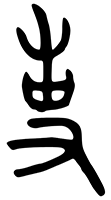6. The "Barb" Radical: 亅
The one-stroke 亅radical is generally quite simple. It's graphically spare and has no variant shapes. It's also simple in that only three Joyo kanji contain this on-duty radical:
事 (293: thing, fact, occurrence; work; nominalizer; to serve)
予 (403: beforehand)
了 (1905: completion; to understand)
The nomenclature is somewhat easy to grasp, too. The main English name is "barb," which is quite logical. Nelson also mentions "hook," which again makes sense. A third possibility, "feathered stick," does not, as I see no feathers on 亅!
The Japanese refer to the radical with these names:
はねぼう
かぎ
I thought はねぼう reflected feathers (羽, はね), as well, but the はね instead corresponds to 撥ね. When calligraphers end a stroke with a hook, that flourish is called 撥ね (はね: flip), a noun counterpart to the verb 撥ねる (はねる: to flip). Incidentally, the insanely elaborate 撥 is non-Joyo. The hook differentiates 亅 from丨(radical 2: the "rod" radical), which is called ぼう (棒: rod) or たてぼう (縦棒: vertical rod). So はねぼう (撥ね棒) means “rod with a hook.” I suspect that "feathered stick" arose from a mistranslation of the はね.
As for かぎ, that mirrors the English name "hook" in corresponding to the non-Joyo 鉤 (hook).
Photo Credit: Eve Kushner
When it comes to 亅, the most interesting thing to contemplate is how many other radicals also include a vertical stroke that hooks at the bottom—or something close to that. Every kanji in this sign has a part that looks painful to touch (as does the red arrow at the top!), but only 予 (403: beforehand) features our radical. Here are the words in the sign:
団体 (だんたい: organization; association)
予約席 (よやくせき: reserved seat)
So group members should head left, where they'll find reserved seats.
Why Are These Kanji Barbed?
Why is亅the radical in the three aforementioned Joyo kanji? Are they in some way barbed? No, this shape contributes no meaning whatsoever to those characters, or not anymore. Here are etymologies from Henshall's newer edition:
事 (293: thing, fact, occurrence; work; nominalizer; to serve)
When it comes to this character, 亅wasn't even in the ancient form. Instead, the early shape looked something like this:

© Richard Sears
Bronze-script version.
Henshall says researchers generally interpret this form as a "hand" holding up part of a branched tree with a sign or banner attached. So the shape at the bottom depicts a hand, not a barbed rod.
予 (403: beforehand)
This shape depicts a weaving shuttle, which moves thread from side to side. By extension 予 represents actions done with the shuttle, such as pushing. Meanings like "beforehand" are generally understood as loan usages, says Henshall.
了 (1905: completion; to understand)
Some scholars see 了 as the pictograph of a child with arms that are withered, twisted, and positioned near the torso. Another expert perceives an infant swaddled with the limbs alongside the body. Alternatively, 了 represents "something twisted" or "a string or cord that has been tied." The contemporary meanings appear to be loan usages.
To sum up, 亅wasn't in the original 事 shape, and the current meanings of 予 and 了 are loan usages. Grouping these three kanji under radical 6 is therefore a matter of convenience, not anything involving a barb or hook.
Photo Credit: Kevin Hamilton
This sign on a shop door translates as "Business has finished for the day" or literally "Today's business has finished." The last kanji compound contains our radical:
本日 (ほんじつ: today)
営業 (えいぎょう: business)
終了 (しゅうりょう: end, close, termination)
